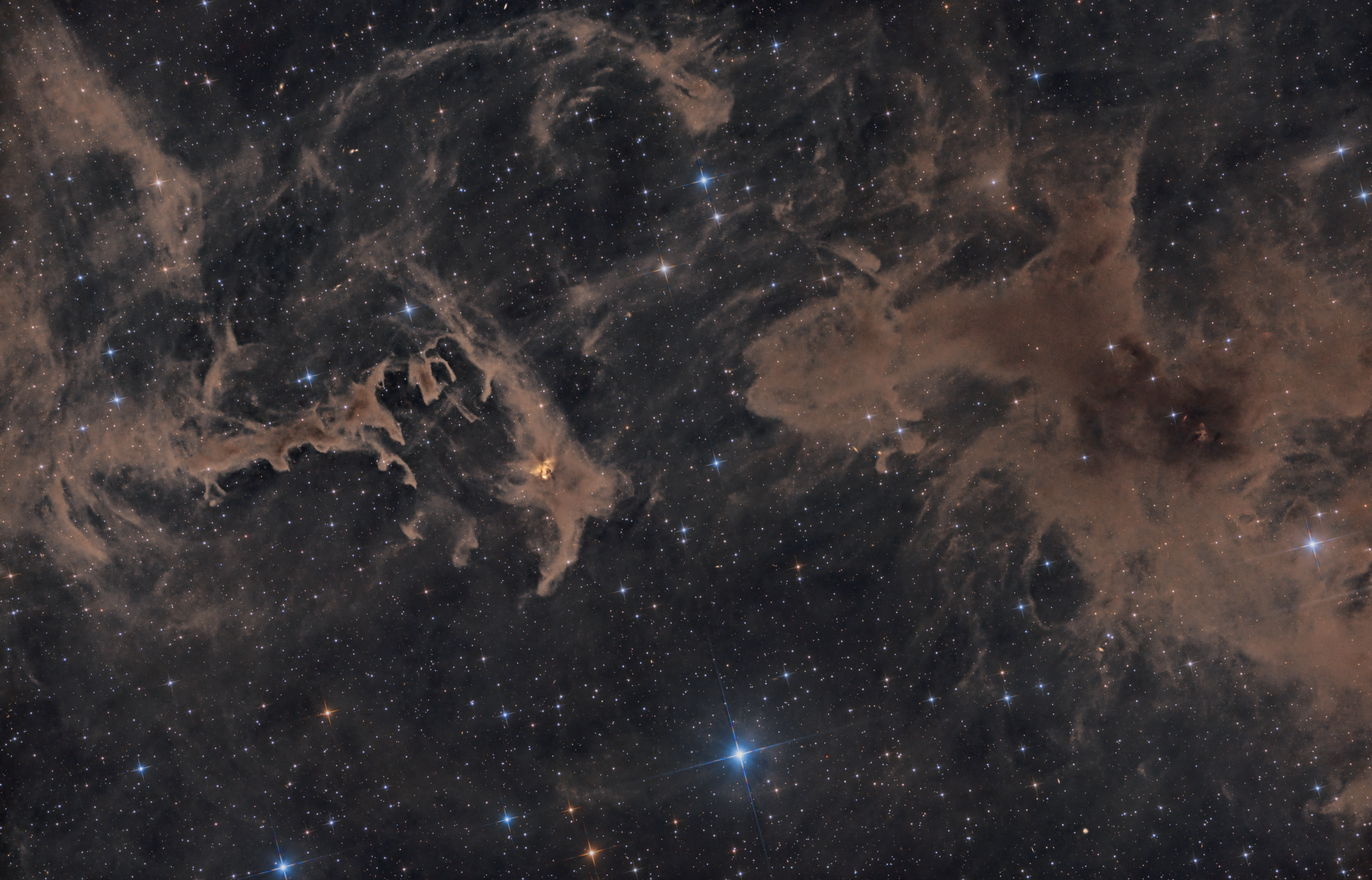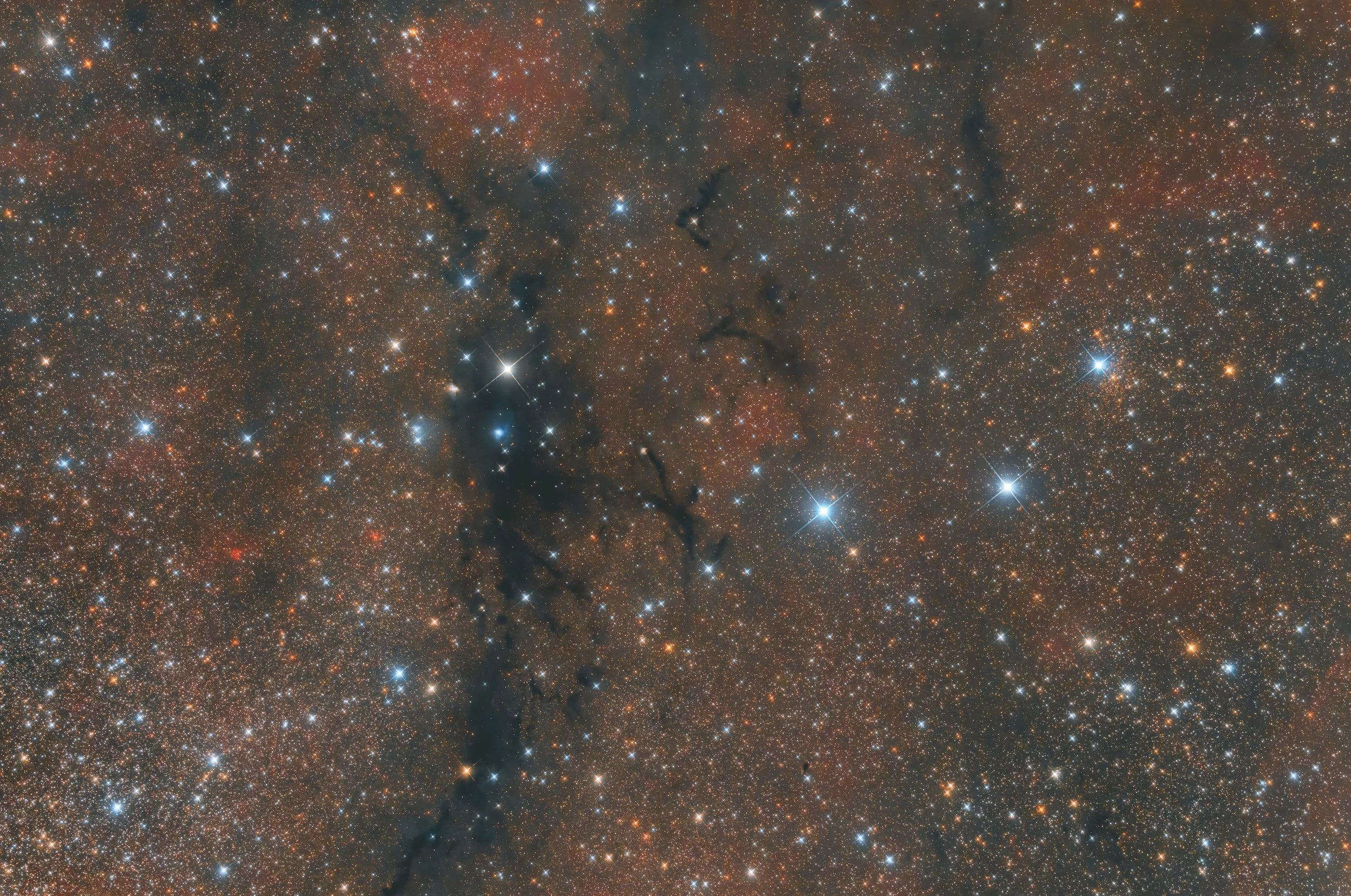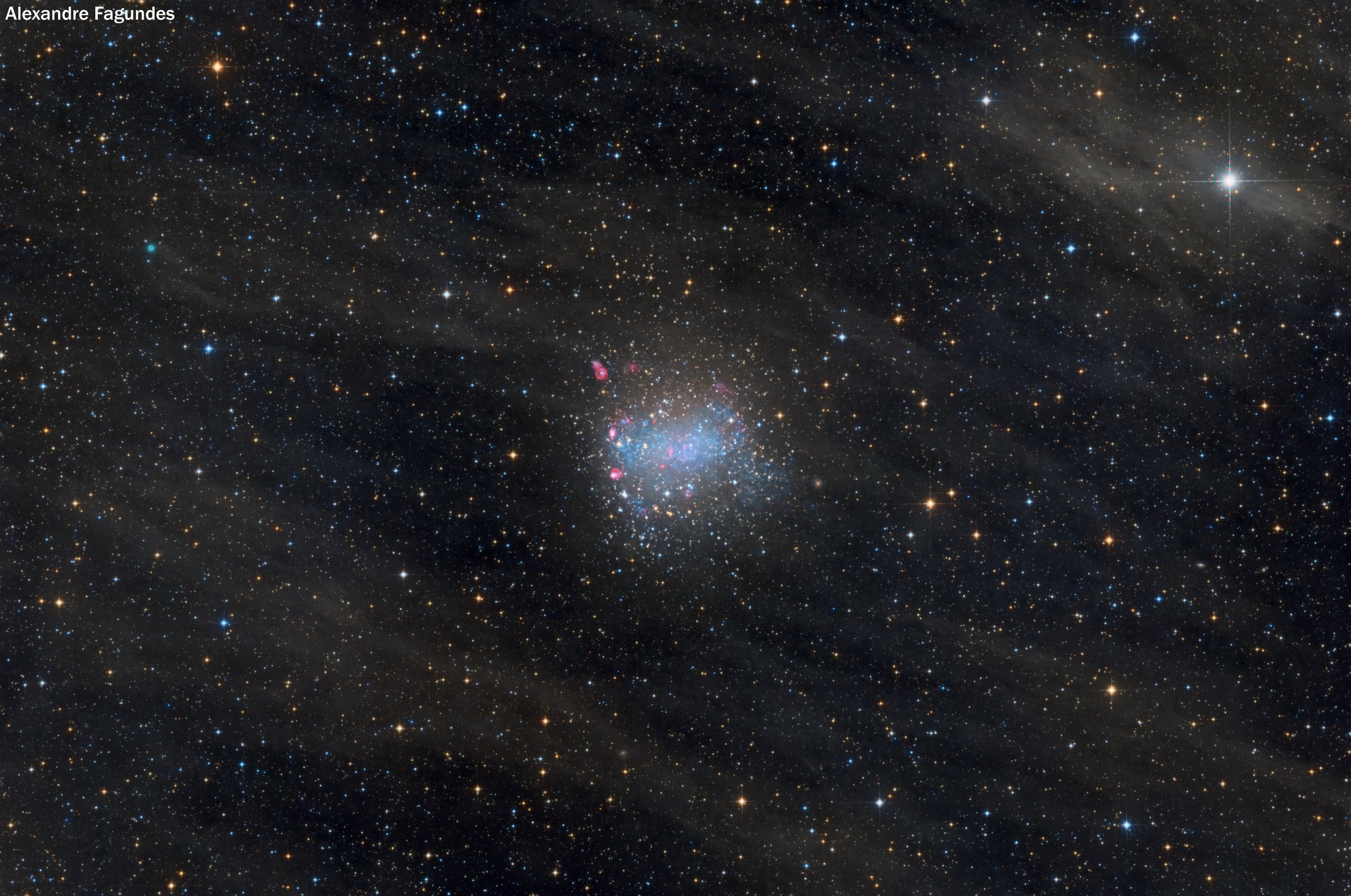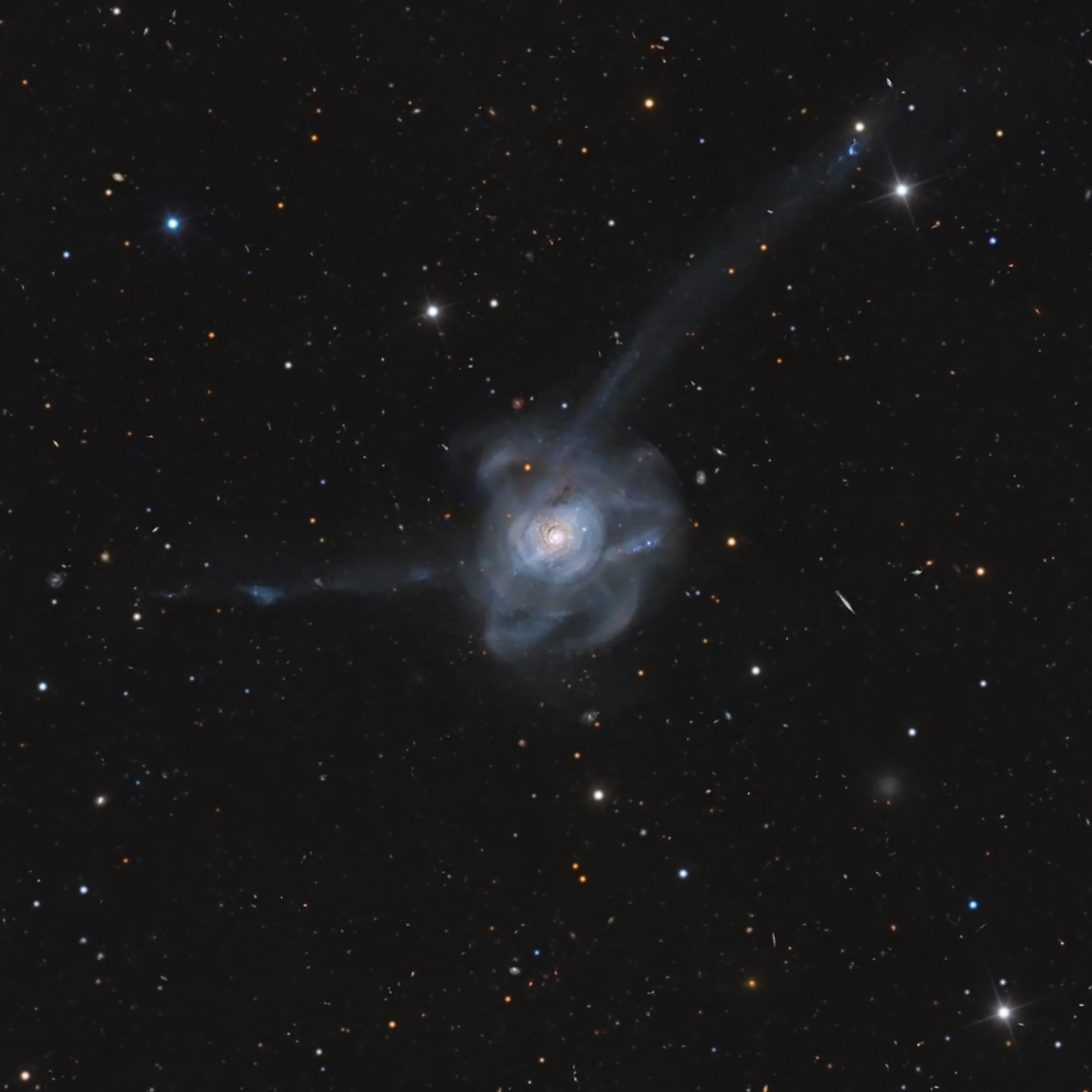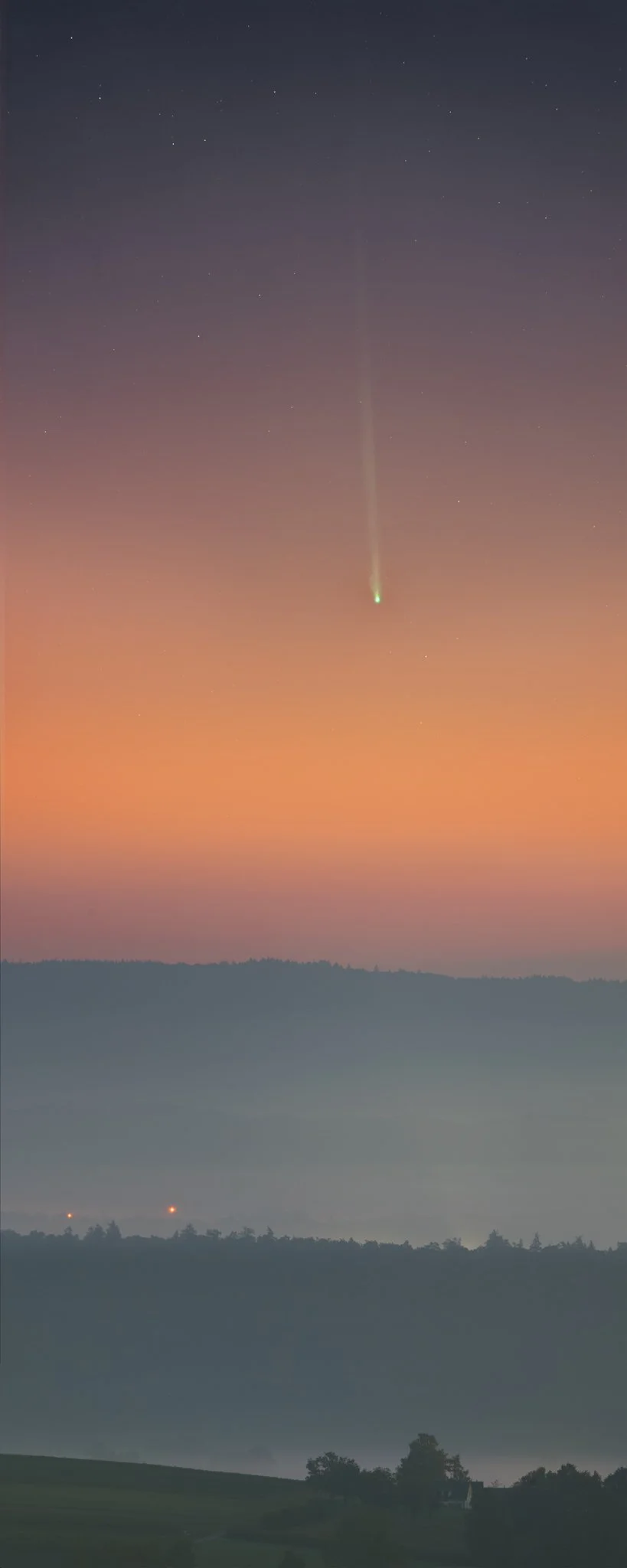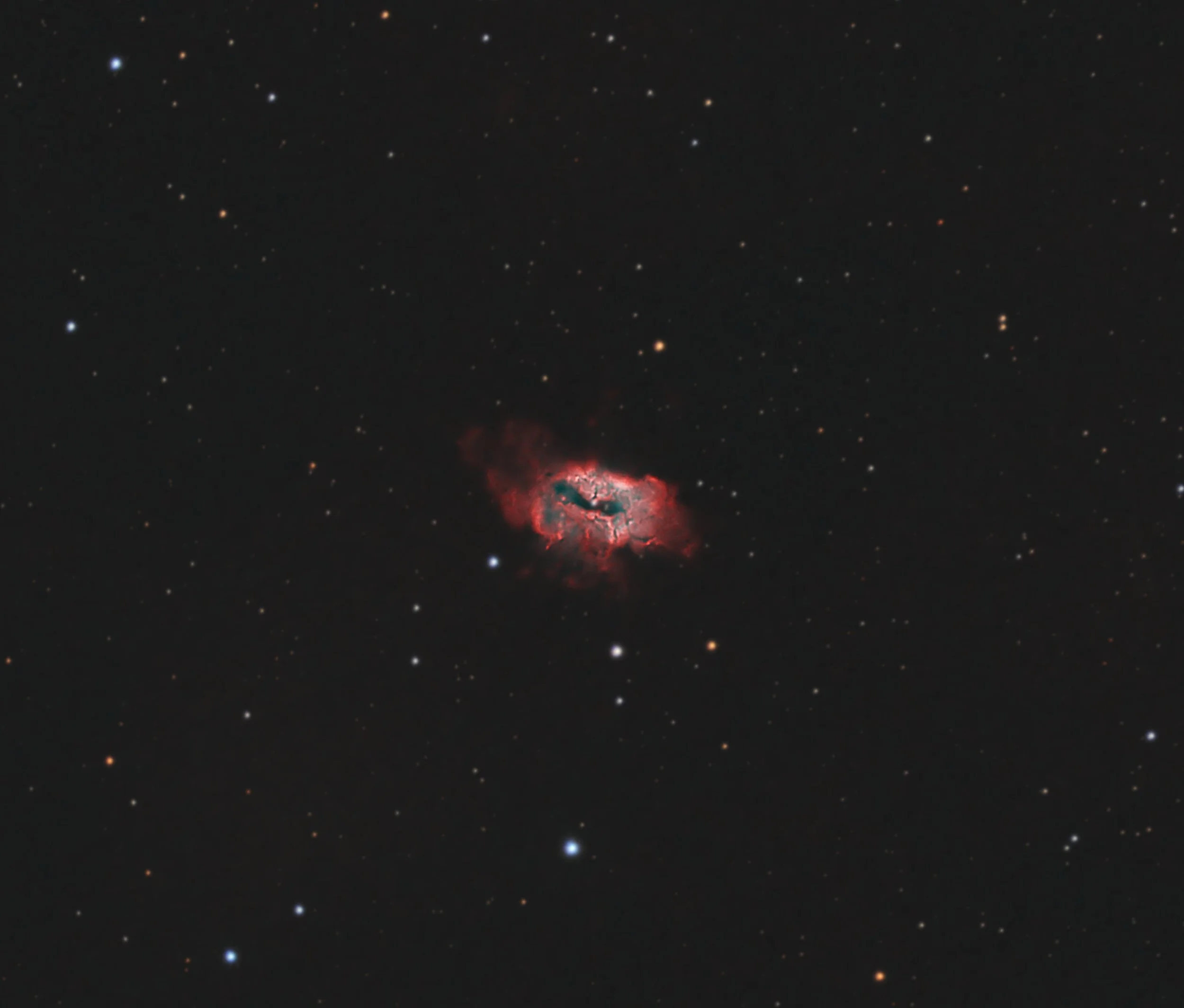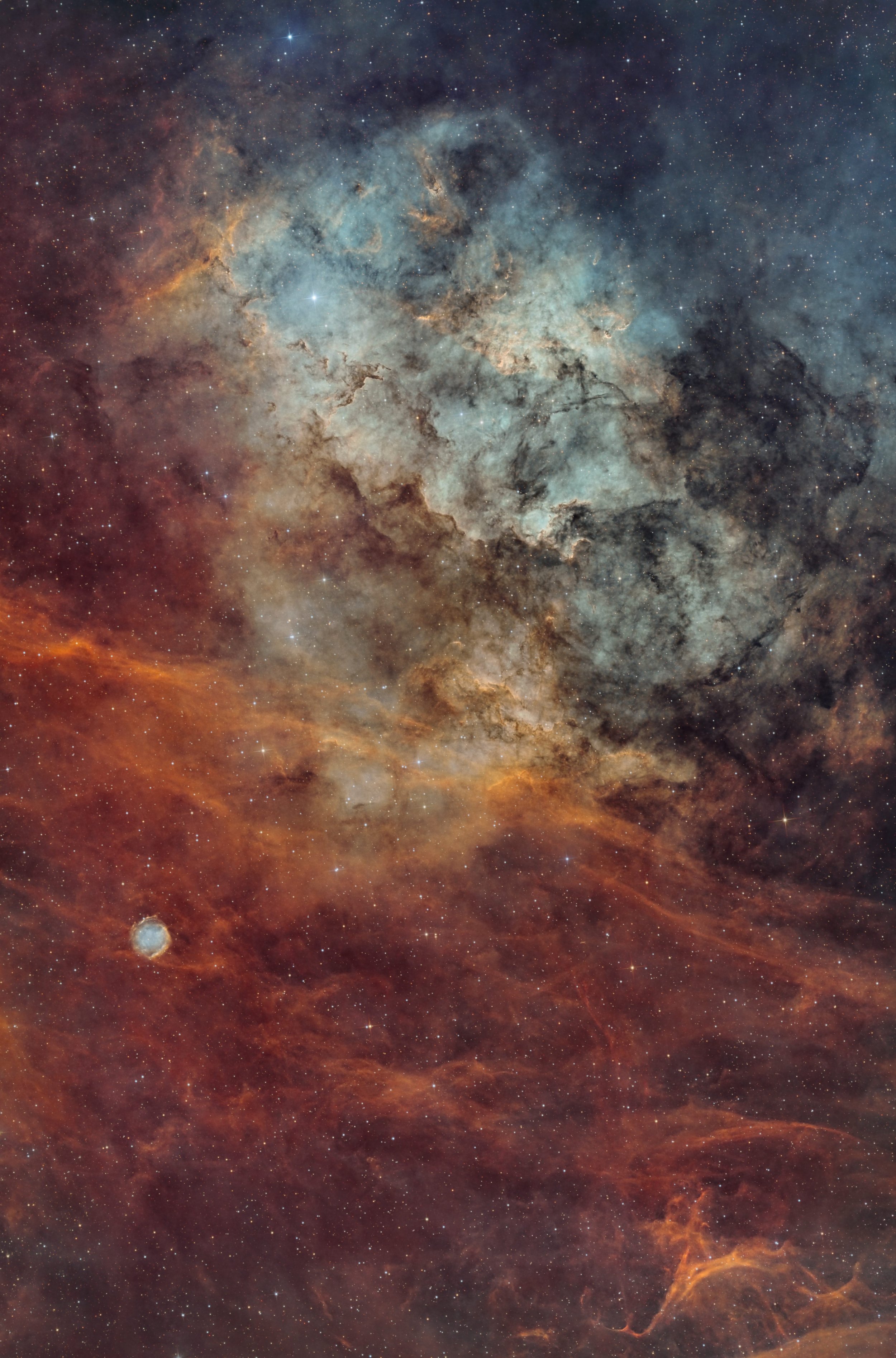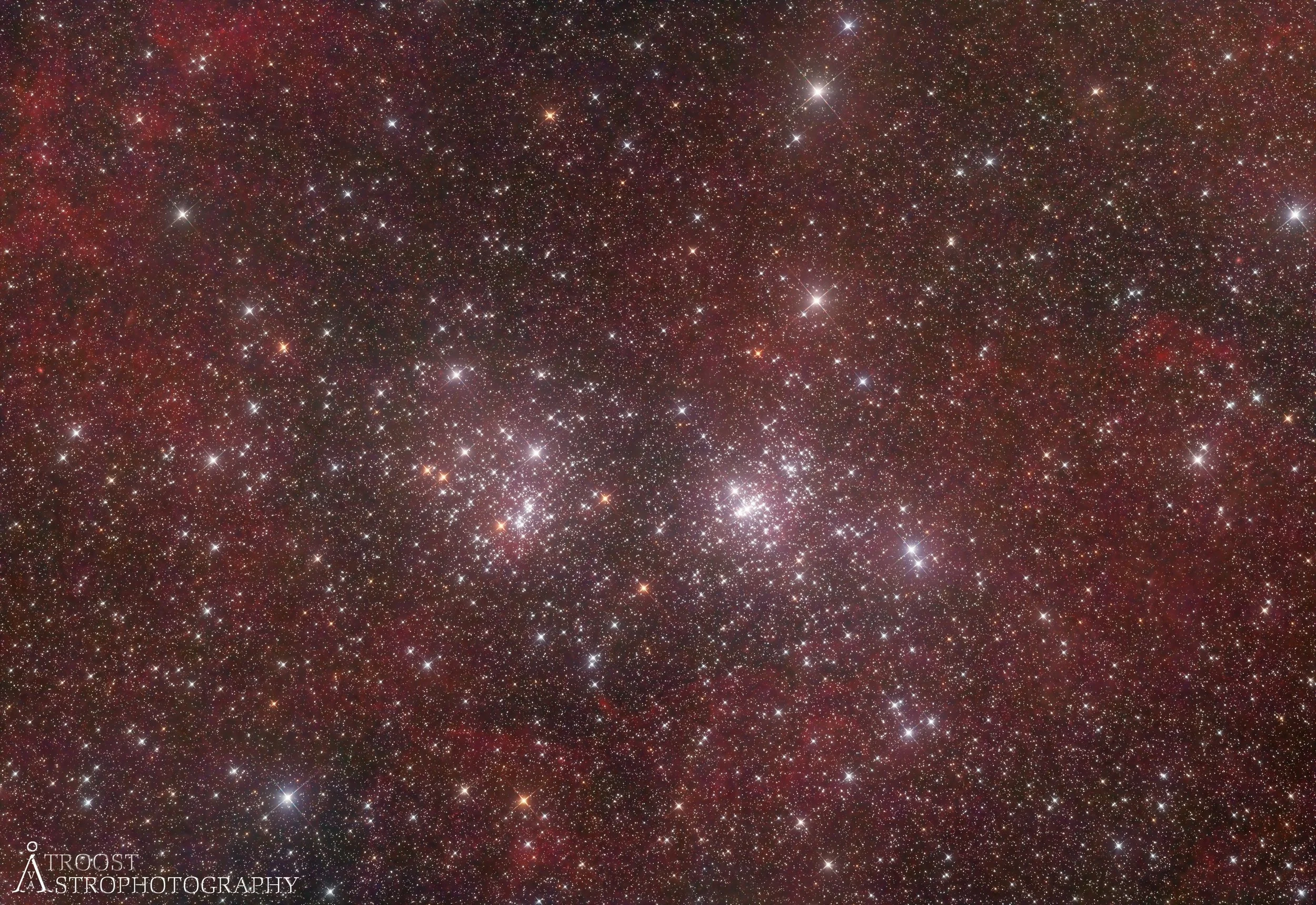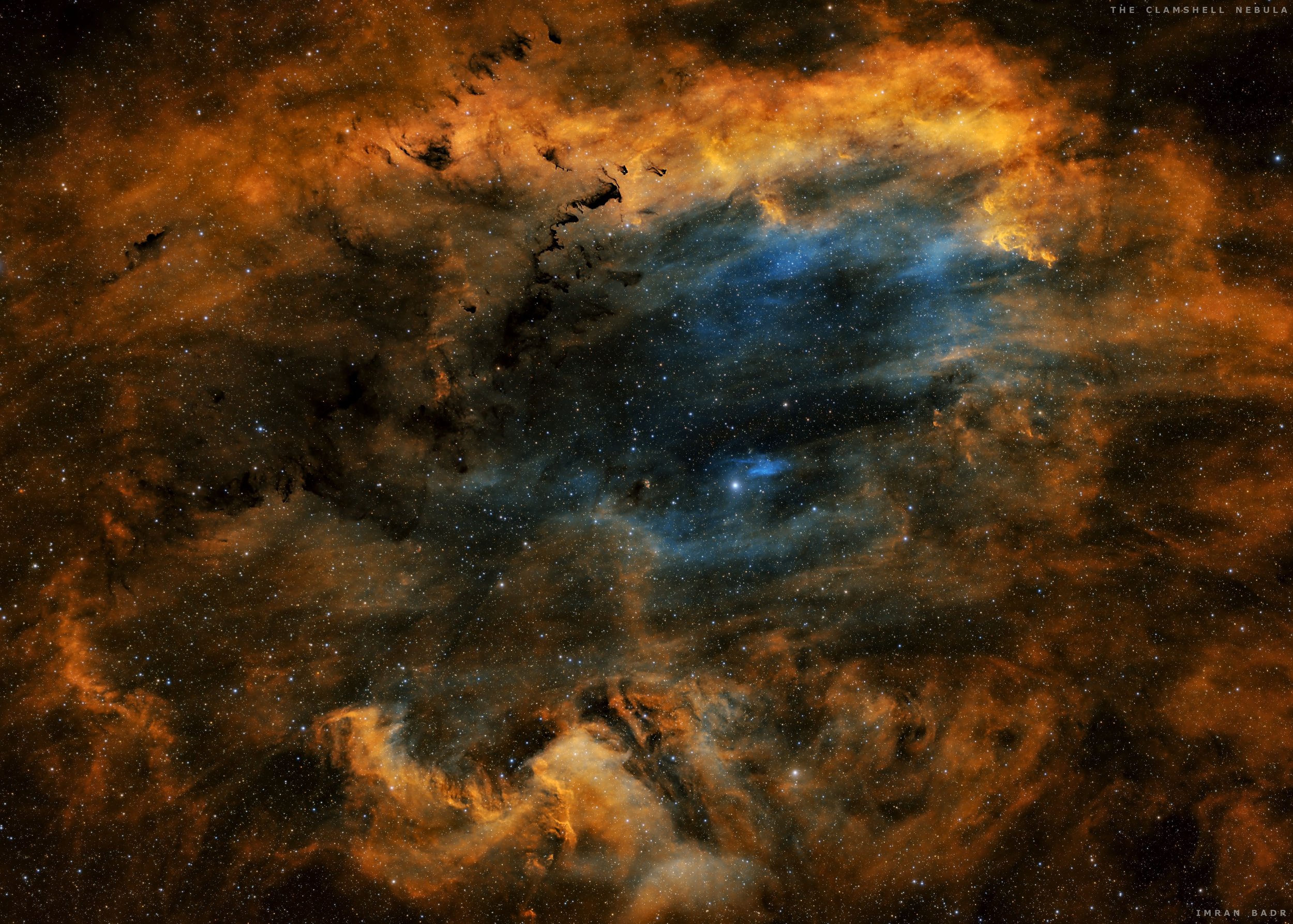
AAPOD2 Image Archives
LBN 552 and LDN 1228
LBN 552 and LDN 1228, a celestial pairing that contrasts light and darkness in the cosmos, come together in this striking image. LBN 552, an emission nebula, stands as a beacon of stellar birth and brilliance, while LDN 1228, a dark nebula, conceals the secrets of cosmic obscurity. Located in the constellation Cepheus, these nebulous regions reveal the intricate interplay of light and shadow in the universe.
In this captivating view, the image unveils the exquisite details of both LBN 552 and LDN 1228, showcasing the radiant reds and blues of the emission nebula juxtaposed against the inky blackness of the dark nebula.
SH2-120
Sh2-120, a celestial gem hidden within the vastness of space, reveals its stunning beauty in this OSC image. Nestled in the constellation Cepheus, this emission nebula is a captivating testament to the cosmic forces at play. Located approximately 6,000 light-years away from Earth, Sh2-120 is a stellar nursery where new stars are born from the surrounding interstellar gas and dust. In this exquisite view. The image showcases the delicate balance of reds, pinks, and blues in Sh2-120, offering a glimpse into the dynamic and ever-evolving tapestry of our universe. This celestial wonder serves as a reminder of the ongoing cosmic drama, where stars are born and the cosmos continually reshapes itself in a breathtaking display of celestial artistry.
IC 1848 (AKA Soul Nebula, Embryo Nebula or W5)
The Soul Nebula, also known as IC 1848, shines with captivating brilliance when viewed through narrowband filters that isolate specific wavelengths of light. This celestial masterpiece, located in the constellation Cassiopeia and approximately 6,500 light-years away from Earth, unveils its ethereal beauty in this narrowband image. The specialized filters emphasize the emissions from ionized hydrogen and oxygen, highlighting the intricate tendrils and glowing clouds of the nebula in stunning detail. In this cosmic portrait, the Soul Nebula's radiant pinks and deep reds come to life, revealing a celestial dreamscape where new stars are born amidst the interstellar clouds. This narrowband view of the Soul Nebula offers a mesmerizing glimpse into the hidden wonders of the universe, where the dance of light and gas paints a masterpiece that transcends both time and space.
The Barnard Galaxy (NGC 6822)
NGC 6822, affectionately known as Barnard's Galaxy, is a small, irregular dwarf galaxy situated in the constellation Sagittarius. Despite its modest size, this celestial gem has captivated astronomers with its intricate structure and stellar richness. Lying about 1.6 million light-years away from our Milky Way, NGC 6822 is considered a satellite galaxy of our own, orbiting the larger Milky Way. Its irregular shape is the result of gravitational interactions with its host galaxy. Within its boundaries, NGC 6822 hosts a diverse population of stars, from young, hot, blue stars to older, cooler, reddish stars, making it a valuable object of study for understanding the evolution of galaxies and the birth and life cycles of stars. This distant galaxy continues to reveal its secrets to astronomers and serves as a testament to the diverse and wondrous objects that populate our cosmic neighborhood.
NGC 7635 Bubble Nebula deep close-up
The Bubble Nebula, designated NGC 7635, is a stunning celestial wonder located in the constellation Cassiopeia. This breathtaking emission nebula is a region of active star formation, where massive stars at the center emit intense ultraviolet radiation, causing the surrounding gas to glow brilliantly. What makes the Bubble Nebula particularly captivating is its spherical, bubble-like structure, created by the powerful stellar winds and radiation from a central massive star known as BD+60°2522. This stellar wind compresses the surrounding interstellar material, sculpting the gas and dust into a shell-like form. The Bubble Nebula is a visual testament to the dynamic interplay between massive stars and the cosmos, offering astronomers a glimpse into the ongoing birth and evolution of stars in our Milky Way galaxy.
Saturn Tethys & Dione
Saturn's captivating moon system includes Tethys and Dione, two intriguing worlds of icy beauty. Tethys, the fifth-largest moon of Saturn, boasts a diameter of around 1,060 kilometers (660 miles). Named after the Greek Titan Tethys, it features the colossal Odysseus crater, spanning approximately 450 kilometers (280 miles). Tethys is further distinguished by mysterious reddish-brown streaks known as 'tiger stripes' that adorn its surface. Meanwhile, Dione, Saturn's fourth-largest moon, with a diameter of about 1,123 kilometers (698 miles), exhibits striking wispy cliffs, thought to be icy fractures. Discovered by Giovanni Domenico Cassini in 1684 and named after the Titan Dione from Greek mythology, these moons have been the focus of scientific exploration, including missions like Cassini-Huygens, which unraveled their secrets and unveiled their unique features.
New Noise in Subaru (m45: aka Pleiades)
M45, commonly known as the Pleiades or the Seven Sisters, is one of the most enchanting open star clusters in the night sky, located in the constellation Taurus. This celestial jewel, situated about 440 light-years away from Earth, is a captivating sight that has fascinated stargazers and storytellers for centuries. In this mesmerizing image, the delicate, blue-hot stars of the Pleiades cluster shine brightly against a backdrop of cosmic dust and gas, creating a celestial spectacle that never fails to inspire awe. The Pleiades have been celebrated in cultures around the world, and their presence in the night sky serves as a timeless reminder of the beauty and wonder that the universe has to offer.
NGC 7252 Atoms For Peace Galaxy
NGC 7252 is a lenticular galaxy 220 million light years away in the constellation Aquarius.
The galaxy is nicknamed the “Atoms “for Peace galaxy because its stars form loop-like structure (tidal tails) that resemble a diagram of electrons orbiting an atomic nucleus. Similar to the logo used by the United States in the 1950’s to promote its Atoms for Peace campaign.
The galaxy is the result of a merger of two galaxies over a billion years ago.
Abell78: little planetary nebula
Abell 78, a captivating planetary nebula residing in the depths of space, tells a story of stellar evolution and celestial beauty. This ethereal cosmic wonder is located in the constellation Cygnus, approximately 5,000 light-years from our home planet. The captivating image showcases the delicate, intricate structure of Abell 78, a shell of glowing gas and dust expelled by a dying star in its final stages of evolution. In this celestial tableau, Abell 78 serves as a poignant reminder of the magnificent transformations that stars undergo as they gracefully exit the cosmic stage, leaving behind a luminous legacy that continues to inspire and captivate our sense of wonder.
NGC 7822
NGC 7822, a celestial jewel nestled in the constellation Cepheus, beckons our gaze from a distance of approximately 3,000 light-years away. This stunning emission nebula is a testament to the relentless forces of cosmic creation, where colossal pillars of gas and dust stand as monolithic sentinels, nurturing the birth of new stars within their shadowy embrace. In this mesmerizing image, the photographer has adeptly captured the vibrant tapestry of NGC 7822, where the intense radiation from newborn stars sculpts and illuminates the surrounding nebular clouds, painting the scene with vivid hues of red and blue. This celestial vista serves as a poignant reminder of the intricate interplay between light and darkness in the cosmic theater, where stars are born from the depths of interstellar chaos, offering a glimpse into the ongoing epic of our ever-evolving universe.
Ldn1251
Ldn 1251, a cosmic enigma nestled within the constellation Cepheus, is a dark nebula that challenges our perception of space and celestial beauty. Located some 800 light-years away, it presents itself as a vast, seemingly empty expanse of space, obscuring the distant stars beyond with its shroud of impenetrable darkness. In this hauntingly exquisite image, the photographer has masterfully captured the subtle, shadowy intricacies of Ldn 1251, revealing a tapestry of cosmic dust and gas. This celestial vista serves as a reminder that even in the absence of brilliant stars and vibrant colors, there is profound beauty in the quiet, mysterious depths of the universe, where the hidden stories of stellar formation and evolution are written in the language of shadows.
The Scream - Full Context (Sh2-92 and SNR G65.3+5.7)
Sh2-92, a lesser-known gem, is a faint but emission nebula residing in the constellation Cygnus, situated approximately 3,000 light-years away from Earth. In this image, the photographer has skillfully captured the subtle hues and intricate filaments of Sh2-92, revealing a stellar nursery where stars are born amidst the glowing gas of interstellar clouds.
Adjacent to Sh2-92, is SNR G65.3+5.7, also known as a supernova remnant, tells a tale of stellar destruction and rebirth. Born from the cataclysmic explosion of a massive star, this celestial remnant has expanded into space, leaving behind a luminous legacy. In this mesmerizing image, the photographer has masterfully combined the delicate features of Sh2-92 with the haunting beauty of SNR G65.3+5.7, offering us a glimpse into the dynamic and interconnected processes that shape the cosmos. Together, these celestial wonders serve as a testament to the ever-changing, awe-inspiring nature of our universe.
The Pastel Comet (C/2023 P1 (Nishimura))
C/2023 P1 (Nishimura) is a long-period comet discovered by Hideo Nishimura on 12 August 2023. With an observation arc of seven months, the orbital period of the comet is estimated to be 434 years.
An eccentricity of 0.996 gives the comet a semi-major axis (average distance from the Sun) of about 57 AU, which is comparable to the average distance of Eris at 68 AU.
The comet will not leave the Solar System and will come to aphelion (farthest distance from the Sun) in 2227.
Sh2-71
Sh2-71, also known as the Ghost Nebula, is a hauntingly beautiful emission nebula found in the constellation Cepheus, approximately 2,400 light-years away from our Earthly vantage point. This celestial apparition is named for its eerie, ethereal appearance, which is evocative of a phantom shrouded in cosmic mist. The Ghost Nebula is brought to life through the radiant glow of hydrogen gas, ionized by the intense radiation of nearby stars. In this captivating image, the photographer has skillfully captured the delicate tendrils and intricate wisps of the nebula, revealing the celestial specter lurking in the depths of space. This haunting celestial vista serves as a poignant reminder of the spectral wonders that await our exploration in the vast expanse of the cosmos.
Sharpless 2-115 and 2-116: a
Sharpless 2-115 is an emission nebula just North and West of Deneb, in the constellation Cygnus. It displays a chaotic morphology of gas emissions and dark nebulae. In the relatively high-resolution image presented here, pillars and Bok globules can be readily identified. Adjacent to Sh2-115 is a round structure originally cataloged as a planetary nebula. Sh2-116 was included in the assigned the catalog number Abell 71 in 1966 and hypothesized to be a planetary nebula by Perek and Kohoutec in 1967 (Perek, L. & Kohoutek, L. 1967, Catalogue of Galactic Planetary
Nebulae) . A morphological study by Pismis, Hasse, and Quintero in 1991 (https://iopscience.iop.org/article/10.1086/132891) reclassified Abell 71/Sh2-116 as an HII region. In their study, Pismis et al claimed that a reason for the reclassification was lack of OIII signal. In the image presented here, as well as other amateur images, OIII in Sh2-116 is clearly present, which leads to question the conclusions of the 1991 study.
Double Cluster in a bed of H-Alpha
The Double Cluster, a celestial gem that graces the northern night sky, is a breathtaking duo of two open star clusters: NGC 869 and NGC 884, situated in the constellation Perseus. This cosmic pair, located approximately 7,500 light-years away from Earth, captivates stargazers with its luminous splendor. Comprising a multitude of young, hot stars, the Double Cluster's brilliance illuminates the surrounding dark skies, making it a favorite among astronomers and amateur stargazers alike. Its stars formed from the same interstellar cloud, yet they embarked on unique stellar journeys, resulting in a spectacular celestial ballet. When observed with binoculars or a telescope, the Double Cluster unveils a resplendent tapestry of stars, providing a glimpse into the captivating intricacies of the cosmos. In this particular image, the photographer has skillfully captured some very faint hydrogen-alpha (HA) emissions, adding an ethereal touch to the already mesmerizing celestial display, revealing the hidden threads that bind these stellar jewels together.
The Edge of the Elephant Trunk
The Edge of the Elephant Trunk
Taken over the course of 33 nights, this is 174 hours of exposure on an area of sky that's rarely imaged alone, but often included in wide field views of Cygnus.
This region is directly north of the Elephant Trunk Nebula, and the faint outer edge of the Elephant Trunk can be seen on the right side of this image.
This is my first image since upgrading to a mono camera, and I couldn't be happier with the switch from OSC to mono.
The Clamshell Nebula (sh2-119)
The Clam Shell Nebula, officially known as NGC 2653, is a captivating celestial formation located in the constellation Camelopardalis, some 300 million light-years away from our own Milky Way galaxy. This mesmerizing nebula earned its popular moniker due to its striking resemblance to a giant clam shell gracefully unfurling in the cosmic depths. Its vivid colors and intricate, filamentous structures are the result of a tumultuous stellar birth and death cycle, where massive stars have exploded as supernovae, sculpting the surrounding gas and dust into a breathtaking display of cosmic artistry. The Clam Shell Nebula serves as a poignant reminder of the perpetual dance of destruction and creation that unfolds across the vast expanse of our universe.
Ngc 7129
NGC 7129 is an open star cluster located in the constellation Cepheus. This cluster is associated with a reflection nebula, meaning it shines due to the scattered light from nearby stars rather than emitting its own light. NGC 7129 is situated approximately 3,300 light-years away from Earth.
Sadr Region 2xPanel Mosaic (50 shades of Red)
The Sadr Region, also known as IC 1318, is a fascinating area in space located within the Cygnus constellation. It is primarily recognized for the emission nebula IC 1318, which spans across a vast expanse of interstellar gas and dust. At its heart lies the prominent star Sadr (Gamma Cygni), which is one of the brightest stars in the Cygnus constellation and serves as a critical reference point for astronomers. This region is a hub of ongoing stellar formation, with numerous young, massive stars emerging from the surrounding gas clouds. Sadr Region's intricate mix of stellar nurseries, star clusters, and intricate nebular structures make it an important target for astrophysical research and a visually captivating sight in the night sky.

